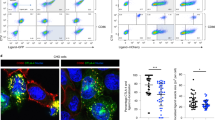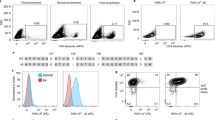Abstract
The CD8 (Lyt 2) molecule is a phenotypic marker for T lymphocytes that recognize and react with major histocompatibility complex (MHC) class I molecules. Antibody blocking experiments1,2 and gene transfection studies3,4 indicate that CD8 binds to a determinant on MHC class I molecules on the target cells, facilitating interaction between effector T lymphocytes and the target cell. The CD8 molecule may also be involved in transmem-brane signalling during T-cell activation5,6. The existence of CD8− cytotoxic T lymphocytes (CTL)7 and class I-reactive CTL that are not inhibited by antibody to CD8 suggests that at least some CTL do not require the CD8 molecule to interact with and lyse target cells. We have recently demonstrated that cells transfected with an H–2Dd gene that carries a mutation at residue 227 are not killed by primary CTL8. Here we show that although this mutation abrogates recognition by primary CTL, it does not affect recognition by CD8-independent CTL, suggesting that residue 227 of class I molecules might contribute to a determinant that is the ligand of the CD8 molecule.
This is a preview of subscription content, access via your institution
Access options
Subscribe to this journal
Receive 51 print issues and online access
$199.00 per year
only $3.90 per issue
Buy this article
- Purchase on Springer Link
- Instant access to full article PDF
Prices may be subject to local taxes which are calculated during checkout
Similar content being viewed by others
References
Swain, S. L. Proc. natn. Acad. Sci. U.S.A. 78, 7101–7105 (1981).
MacDonald, H. R., Glasebrook, A. L., Bron, C., Kelsoe, A. & Cerrotini, J. C. Immunol. Rev. 68, 89–115 (1982).
Dembic, Z. et al. Nature 326, 510–511 (1987).
Gabert, J. et al. Cell 50, 545–554 (1987).
Fleischer, B., Schrezenmeier, H. & Wagner, H. J. lmmun. 136, 1625–1628 (1986).
van Seventer, G. A., van Lier, R. A. W., Spits, H., Ivanyi, P. & Melief, C. J. M. Eur. J. Immun. 16, 1363–1371 (1986).
Yui, K., Hashimoto, Y., Wadsworth, S. & Greene, M. I. J. exp. Med. 166, 1026–1040 (1987).
Potter, T. A., Bluestone, J. A. & Rajan, T. V. J. exp. Med. 166, 956–966 (1987).
Potter, T. A., Palladino, M. A., Wilson, D. B. & Rajan, T. V. J. exp. Med. 158, 1061–1076 (1983).
Evans, G. A., Margulies, D. H., Shykind, B., Seidman, J. G. & Ozato, K. Nature 300, 755–757 (1982).
Allen, H., Wraith, D., Pala, P., Askonas, B. & Flavell, R. A. Nature 309, 279–281 (1984).
Bjorkman, P. J. et al. Nature 329, 506–512 (1987).
Bjorkman, P. J. et al. Nature 329, 512–518 (1987).
Marguiles, D. H. et al. J. Immun. 130, 463–470 (1983).
Potter, H., Weir, L. & Leder, P. Proc. natn. Acad. Sci. U.S.A. 81, 7161–7165 (1984).
Ajitkumar, P. et al. Cell 54, 47–56 (1988).
Levy, R. B., Ozato, K., Richard, J. C. & Bluestone, J. A. J. Immun. 134, 1342–1348 (1985).
McCluskey. J. et al. J. Immun. 137, 3881–3890 (1986).
Author information
Authors and Affiliations
Rights and permissions
About this article
Cite this article
Potter, T., Rajan, T., Dick, R. et al. Substitution at residue 227 of H–2 class I molecules abrogates recognition by CD8-dependent, but not CD8-independent, cytotoxic T lymphocytes. Nature 337, 73–75 (1989). https://doi.org/10.1038/337073a0
Received:
Accepted:
Issue Date:
DOI: https://doi.org/10.1038/337073a0
This article is cited by
-
Temporal transcriptome changes induced by MDV in marek's disease-resistant and -susceptible inbred chickens
BMC Genomics (2011)
-
A third broad lineage of major histocompatibility complex (MHC) class I in teleost fish; MHC class II linkage and processed genes
Immunogenetics (2007)
-
Structural basis for a major histocompatibility complex class Ib–restricted T cell response
Nature Immunology (2006)
-
Thymic selection threshold defined by compartmentalization of Ras/MAPK signalling
Nature (2006)
-
Tumor-infiltrating T lymphocytes: friends or foes?
Laboratory Investigation (2006)
Comments
By submitting a comment you agree to abide by our Terms and Community Guidelines. If you find something abusive or that does not comply with our terms or guidelines please flag it as inappropriate.



